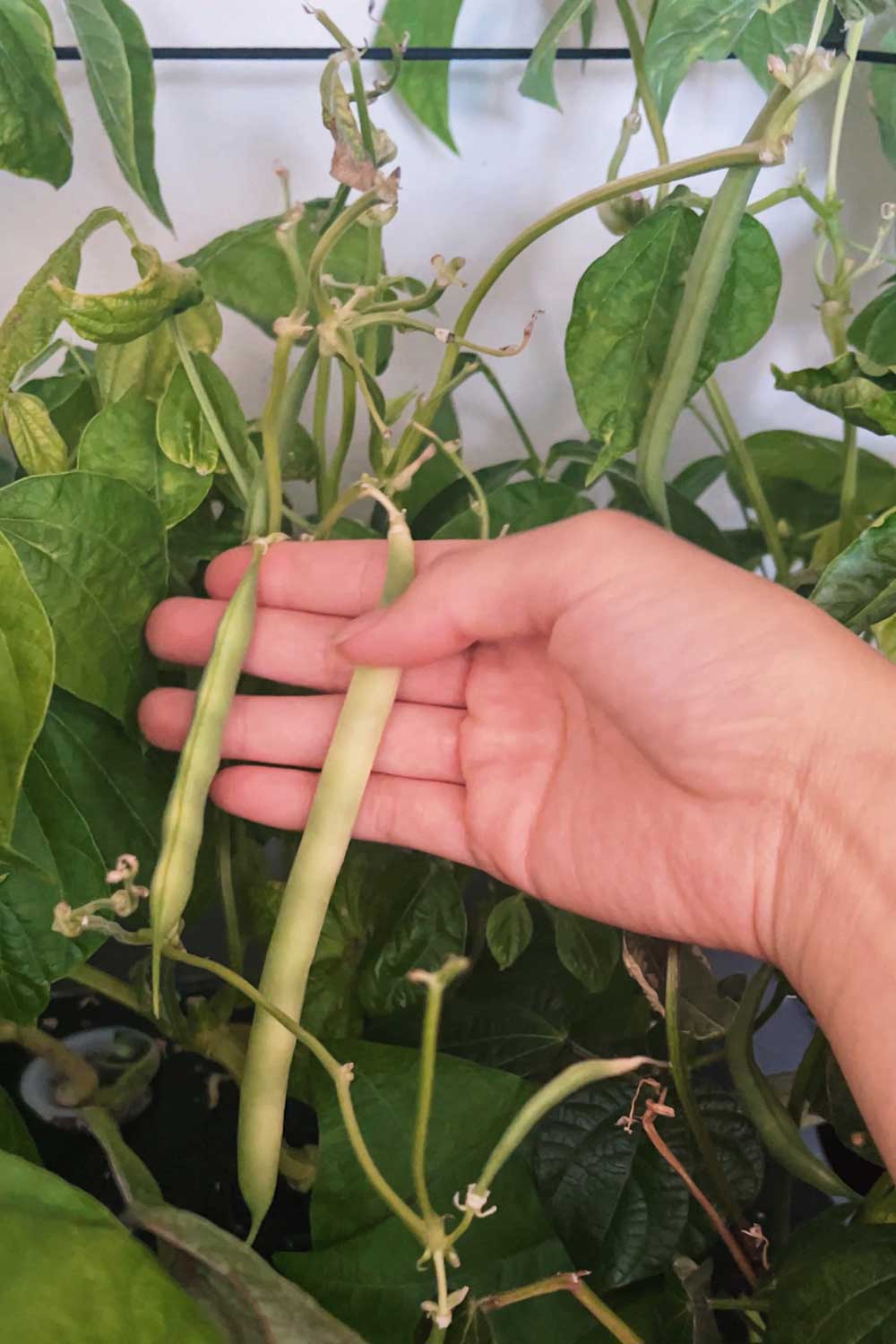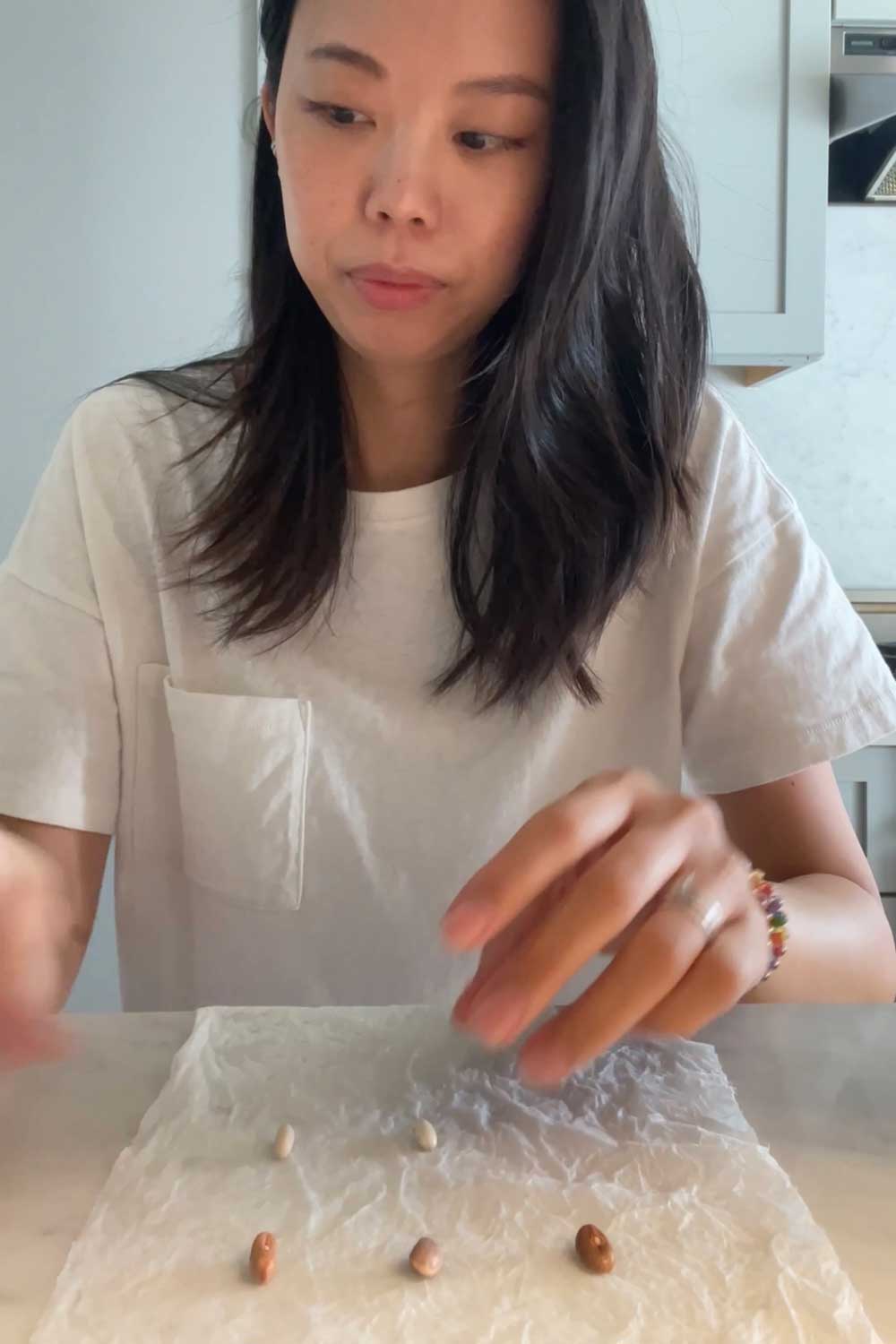Gold Rush Bush Beans
I was initially drawn to Gold Rush beans for their color – these light yellow pods grow in sunny clusters that pop amongst all the green.
And then I realized how delicious they are!
Gold Rush beans are one of the best wax beans available, thanks to their large crop production. They hold their texture and quality in the garden longer than other beans, are resistant to most common bean diseases and also freeze well.
And if you have just a small space, Gold Rush beans are compact and container friendly!
I grew mine indoors, alongside several other bean varieties, and they were the earliest to produce pods.
So if you’ve ever wanted to try growing beans, Gold Rush are a good option.
Here’s everything I’ve learned about growing gold rush beans.
Gold Rush Beans
Beans are an ancient crop, believed to date all the way back to 8,000 BC in Pre-Incan Peru.
When Columbus arrived in the New World, he found Indians growing green beans alongside maize, demonstrating that even old civilizations recognized the value of companion planting.
Today, there are hundreds of varieties of beans, in all shapes, sizes and colors.
I picked up Gold Rush beans from Botanical Interests, but they’re available at lots of online heirloom seed companies.
These yellow beans are basically the same as green beans, but a fun variety to add some color to your meals. They’re tender and sweet, with great flavor, and also a good source of vitamins A, C, and K as well as folate and manganese.
Buy seeds: Amazon, Botanical Interests, True Leaf Market
Keep reading, or pin this article to save it for later ⇟

Beans prefer warm weather, especially in the beginning stages of growth, so you’ll want to wait until the soil temperature is well past the threat of frost and quite warm – at least 60°F but ideally 70°–85°F. If the soil is too damp, bean seeds will rot. Sow seeds directly outside, leaving about 4-6″ between plants, in rows 2-3′ wide. Plant seeds in succession, every 7 to 14 days, to ensure continuous harvests. Gold Rush beans produce a main bulk harvest all at once so you’ll want to stagger planting for beans all season long. Seeds sprout quickly, in 4-10 days, and need light watering at the beginning, then medium at flowering and heavy at harvest time. Water as close to the root as possible – bean plants don’t like wet leaves which can lead to disease. Bush beans are generally considered quite easy to grow, since they have low fertilization requirements and are resistant to most common pests and diseases. Bush beans grow in short, squat bush-like shapes so they don’t require support. Gold Rush beans are especially quick to mature, with pods ready to harvest ~55 days after planting. I grew my Gold Rush beans indoors, in my hydroponic smart gardens. I love being able to grow vegetables all year round. Typically, beans would be limited to just the summer months but with Aerogardens, I don’t have to worry about time pressures. I also had a couple rough starts with the beans, so being able to start multiple rounds at the end of August would only have been possible with my indoor gardens. Indoor Gardens Use Your Own Seeds Use SSG15 for 15% off any order of $50+Bush Beans Grow Guide
Botanical Name
Phaseolus vulgaris
Common Name
Gold rush beans, gold rush bush beans, gold rush wax bean, yellow bean
Mature Size
16-20 inches tall
Days to Harvest
54 days from seed
Light
Full sun
Soil Type
Well draining soil
Soil pH
Neutral (6.0 – 6.8)
Hardiness Zones
USA Zones 3-10
Native Area
Mexico and South America
Pests
Bean beetles, aphids, spider mites, leafhoppers
Diseases
Root rot, white mold
Planting Gold Rush Beans
Growing Gold Rush Beans Hydroponically
Best Indoor Gardening Products to Grow Bush Beans
Aerogarden Discount Code
How to Grow Gold Rush Wax Beans
A video grow guide covering everything you need to know about growing yellow beans!
https://youtu.be/Lz272JRa8qA
Starting Bean Seeds
I initially started seeds directly in the Aerogarden pods, but quickly realized that was a mistake.
Bean seeds rot incredibly easily, and most of the ones I planted grew mold, upside down in the wrong direction or didn’t germinate at all.
So I switched to starting seeds with the paper towel method, which had a 100% success rate.
I highly recommend using the paper towel method with any tricky-to-start vegetables, like beans.
Once the seeds have sprouted and have 2-3″ long white roots, you can transplant them to the Aerogarden machines.
Just make sure to pick up the Grow Anything kit, which has empty sponges, pods and labels so you can use your own seeds.
From there, the beans took off in the Aerogardens!
I planted 5 bean plants in the Farm 24xl, which ended up being more than enough vertical height. In general, bush bean plants need about 3 spaces to comfortably grow and about 24″ of height.
In the future, I’d grow these in the Bounty and not the Farm.
Fertilization
I used the Aerogarden liquid nutrients every 14 days, but found that it was a bit too much fertilizer for the plants.
Beans only need a moderate amount of nutrients, and too much nitrogen can actually cause pods not to set, or delay maturity altogether. Bean plants themselves produce nitrogen, so if you’re also adding too much nitrogen fertilizer, it can be overkill.
The way to tell if your plants have enough nutrients is by checking the leaves.
I found that immediately after adding nutrients, if the nitrogen levels got too high, the bean plant leaves turned yellow.
It takes a bit of trial and error, but I found that topping up nutrients every ~3 weeks or so seemed to work.
I did continue to add a flower fertilizer though, as I noticed the plants produced tons of white flowers but didn’t set pods.
Difficulties with pod production can be helped with a bloom fertilizer that has extra phosphorus, or adding additional zinc through a kelp-based fertilizer.
Pruning and Maintenance
I had always heard bush bean plants don’t need support, but found that indoors, my Gold Rush bean plants quickly grew into a sprawling mess.
I ended up adding the Farm trellis to provide additional support for my bush bean plants.
Bush beans were cultivated from pole bean plants, and occasionally display some of their pole bean tendencies, stretching long and tall via climbing tendrils.
The grid trellis seemed to help a lot, as did pruning excess leaves.
Eventually, the beans settled into compact shapes.
You can also add a fan to help increase air circulation and flower fertilization.
How Tall do Gold Rush Beans Grow?
Gold Rush beans are a bush bean variety, so they stay in compact, squat plants about 1.5 feet tall.
The beans themselves form clusters of light yellow pods, in bunches that are easy to spot and pick. The pods vary in size, about 4-6″ in length, and are crisp, tender and tasty!
How to Harvest Gold Rush Beans
Gold Rush beans produce the bulk of their beans in one go, over a 2 week time span.
The beans start off green, and gradually lighten to a pale yellow as they mature. The pods themselves are slender, flavorful and tender with thin walls.
Keep the plants well picked to encourage max productivity!
The smaller the bean, the more tender they’ll taste. You can harvest by hand, but just don’t tug too hard or you’ll risk breaking the plant. I always prefer to use sharp garden shears.
Pick beans regularly to encourage the plant to keep producing. If the pods get fat with seed, the plant will stop flowering and no longer make new beans.
After the initial main harvest, Gold Rush beans will continue to produce beans, but in smaller quantities. So if you want to be able to continuously harvest beans all season long, make sure to succession plant new bean seedlings every 2 weeks.
How to Save Bean Seeds
If you’d like, you can also save seeds.
Beans are one of the easiest plants to save seeds from.
Let the pods dry out on the vine – you’ll immediately notice when they’ve gone too long because the pod will shrivel up and turn a light brown color.
The flesh will be dry and wrinkly, and you’ll see the bulges from where seeds have formed.
Pluck the pods off the plant and open them to reveal fresh white seeds inside.
Allow the seeds to completely dry, then store in an airtight container for up to a year.
How to Store Gold Rush Beans
Gold Rush beans store pretty well.
Place them in the fridge in a container with a paper towel to soak up moisture. They should keep for a few weeks, but freshly picked beans taste the most tender at harvest so eat them as soon as possible!
You can also store beans longer term by blanching them. Prepare a pot of boiling water and dunk the beans in for a quick soak. This also helps preserve their color.
Then let dry and store in bulk in a ziplock bag in the freezer.
Or, you can preserve beans by pickling them. Pickle in jars with vinegar and sprigs of dill for flavor.
harvesting gold rush beans
more hydroponics + recipes on tiktok @shershegrows
How to Cook Gold Rush Beans
Gold Rush beans taste great raw or cooked.
Try steaming them for a healthy dinner, or dress them in a vinaigrette for crunch to a salad. You can also sauté them in olive oil and salt, or boil them and toss with butter.
I also like them as a crudité with an herb dip!
Bean Recipes
coming soon!
Follow me on













